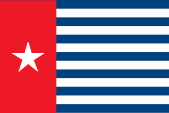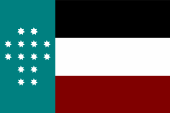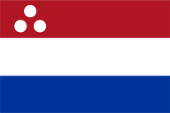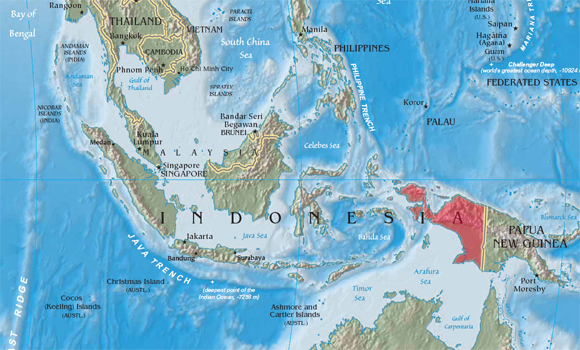mobile View, to the German Version tap the flag


- Western New Guinea (West Papua)
- to 1962 Dutch possession
- 1961–1962 Dutch possession with self administration
- 1962–1963 autonomous territory under UN government
- 1963 annexed by Indonesia, since then a region with separatistic ambitions
- own names: Irian Barat, Irian Jaya
• Flag
• Historical Flags
• Meaning/Origin of the Flag
• Map
• Numbers and Facts
• History
• Origin of the Country's Name

1961–1963,
National flag,
ratio = 2:3,
Source:
Wikipedia (DE)





1988,
Flag of West Melanesia,
ratio – ratio = 2:3,
Source, by: Wikipedia (EN)




1949–1962,
Flag for the Governor of Netherlands Guinea,
ratio – ratio = 2:3,
Source, by: Die Welt im bunten Flaggenbild




The flag of Western New Guinea (Papua Barat) was adoped by the Nieuw-Guinea Raad the by the Netherlanders administered interim state on 19th of October in 1961 was hoisted for the first time on 1st of December in 1961. The flag is called "Morning Star" (Bintang Kejora, Dutch: Morgenster) and shows thirteen alternating blue and white stripes and on the mast a vertical red bar with a white star in the middle. The colours of the flag go back to the Dutch tricolour. In connection with occupation of the country by Indonesia, the flag was banned on 1st of December in 1963. The use is punished. Anyone who uses it is in danger of life and, should there be a trial, can be punished with up to 20 years imprisonment. In practice, the blue is often presented in different ways. Likewise, the width of the red strip and the size of the star often deviate from each other. On 1st of July in 1971, Brigadier General Seth Jafeth Rumkorem, the leader of the OPM, proclaimed the Republic of West Papua (Papua Barat) and the flag was adoped once again. In the year 1988 Dr. Thomas Wapay N. S. Wainggai tried to introduce a new flag in context with the proclamation of the Republic of West Melanesia on 14th of December in 1988. It was a draft of his Japanese wife and showed three horizontal strips in black, white and red and on the mast a vertical green stripe with 14 white stars. Wainggai was detained, the project ended and the flag seems forgotten. At least it could not prevail as a counter-draft to the Morning Star flag.
Source:
Wikipedia (EN),
Wikipedia (NL),
Wikipedia (EN)

Location:

Source: Freeware, University of Texas Libraries, modyfied by: Volker Preuß
Map of Western New Guinea, 1916:

enlarge: click or tap here
Source: public domain via: Commons Wikimedia

Area: 162.927 square miles
Inhabitants: ca. 2.930.000 (2002), thereof 52% Papua, 48% Indonesians
Density of Population: 18 inh./sq.mi.
Capital: Jayapura (named to 1962 Hollandia, then Kotabaru, to 1968 Sukarnopura), 257.000 inh. (2010)
official Language: Bahasa Indonesia
other Languages: Melanesian Languages, Dutch
Currency: Indonesian currency
Time Zone: GMZ + 9 h
Source:
Wikipedia (DE)

1528 · the Portugese Meneses discovers New Guinea
1527 · the Spaniard Saavedra explores the northern coast of Western New Guinea
1546 · Spanish appropriation, however, no colonization
1605 · out of the Molucca Islands initiated begining Dutch colonization in the exceedingly northwest of Western New Guinea
1606 · the Spaniard Torres explores the southern coast of Western New Guinea
1616 · the Netherlanders La Maire and Schouten reach Western New Guinea from East
1828 · the Netherlands appropriate whole Western New Guinea, part of Netherlands East-Indies
1942 · Japanese occupation of nearly whole Western New Guinea
1944 · landing of allied troops, expulsion of the Japanese until 1944, return of the Dutch
1952 · the Netherlands grant Western New Guinea inner self-administration (autonomy)
1961 · election of the first parliament of Western New Guinea (Nieuw Guinea Raad), joint decision with the Netherlands for independence in the year 1970
1962 · attack by Indonesian troops, followed by New York Agreement
1st of October in 1962 · because of the New York Agreement Western New Guinea is handed over from the Netherlands to the UN
1st of May in 1963 · Western New Guinea is handed over from the UN to Indonesia and becomes incorporated as a province, in the next 50 years, 800.000 Indonesians will immigrate and about 100.000 Papua (every seventh member of this nation) will lose their lives by force
1964 · establishing of the Papua independence movement Organisasi Papua Merdeka (OPM)
1971 · Brigadier General Seth Jafeth Rumkorem, leader of the OPM, proclaimes the Republic of West Papua (Papua Barat)
1988 · Dr. Thomas Wapay N. S Wainggai proclaimes on 14th of December in 1988 in Manclula Sports Stadium of Jayapura the Republic of West Melanesia, he is arrested and sentenced to 30 years imprisonment, he dies 1996 in prison
2001 · Indonesia grants the province of West New Guinea (Papua Barat) internal autonomy on 1st of January 2001
2002 · Indonesia renames the province in Papua on 7th of January in 2002
2002 · establishing of the West Papua Liberation Organization (WPLO)
2003 · Indonesia divides the province unilaterally and under large protests in two parts: Irian Jaya Barat and Papua
2011 · Forkorus Yaboisembut, head of the West Papua National Authority (WPNA), proclaimes on 19th of October in 2011 the Federal Republic of Papua (Negara Republic Federal Papua Barat)
2014 · all independence movements of West New Guinea are united under a single umbrella organisation, the United Liberation Movement for West Papua (ULMWP)
2017 · The West Papua National Liberation Army (WPLNA, TPN-OPM) succeeds in occupy the villages of Kimberly and Banti near the Grasberg mine for 8 days
Source:
Wikipedia (DE),
Atlas zur Geschichte,
Die Völker der Erde,
Discovery '97,
Weltgeschichte

Irian Jaya has many names. So for example West New Guinea. It is in this way placed right in the west of the island of New Guinea, where a majority of Papuan peoples live. They call the island Papua. Hence declares itself the regional name of the country, which had an own administration between 1962 and 1963 and was only under the supervision of the UN: Irian Barat, what means West Papua. The island of New Guinea also has an old Indonesian name: Irian. Thus the Indonesian name for the region is explained: Irian Barat, what means West Irian.
Source:
Volker Preuß


![]()












